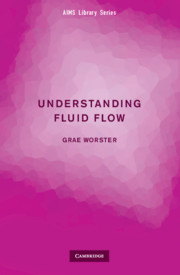2 - Parallel viscous flow
Published online by Cambridge University Press: 30 April 2024
Summary
Momentum equation
There is a balance between pressure forces that drive the flow of a viscous fluid and viscous stresses that retard (slow down) the flow. We can begin to understand this balance by examining a few special cases in which all parts of a fluid are flowing in the same direction, namely parallel flow. Consider a steady fluid flow of the form u = (u(y), 0, 0) in Cartesian coordinates (x, y, z), and the forces acting on a slab of fluid parallel to the x-axis, as shown in Figure 6. The vertical sides of the slab experience pressure forces in the x direction, while the horizontal sides of the slab experience tangential shear stresses in the x direction from the surrounding fluid. Since the flow is steady, the forces on the slab must balance, giving us
Note that the normal to the upper surface of the slab points into the surrounding fluid in the positive y direction, while the normal to the lower surface of the slab points into the surrounding fluid in the negative y direction. This gives us
Therefore, if we divide the expression for the force balance by δxδy, we obtain
Taking the limits δx → 0, δy → 0, we obtain
If we use a similar approach to resolve forces in the y direction (transverse to the flow), we find that
Exercise 1 If a parallel flow u = (u(y, t), 0, 0) is unsteady (changing with time t) and there is a body force (force per unit volume) f = (fx, fy, 0) acting on the fluid, show that
For example, if x points horizontally and y points vertically upwards then f = (0,−ρg, 0). These are the x and y components of the momentum equation for a fluid in parallel flow, with x in the direction of the flow and y transverse to it.
Boundary conditions
Before we can solve a flow problem, we need boundary conditions for the momentum equation. At a stationary, rigid boundary the velocity is zero because of the no-slip condition:
At a fluid–fluid boundary the velocity and both components of the stress are continuous.
- Type
- Chapter
- Information
- Understanding Fluid Flow , pp. 9 - 24Publisher: Cambridge University PressPrint publication year: 2009

